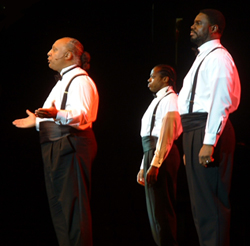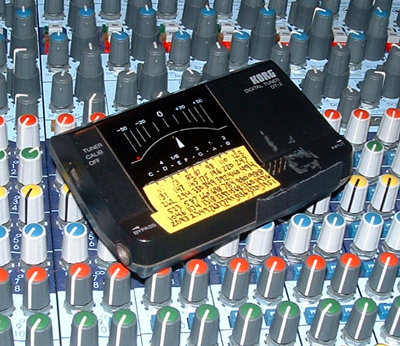
One day, I fished out a cheap Korg guitar tuner some ‘folkie’ had dropped behind the radiator, looked at it and realized it was a perfectly good 1/12-octave frequency analyzer.
For a tone generator, I inserted a Casio CZ101 synth with a sine-wave patch up on the mixer, with the keys labeled by frequency.
I could cue it up in the ‘cans’ during a show at the first sign of a resonance and identify the problem with laser accuracy. Of course, this was before laptop analyzers became common.
Gary: Sounds like a light bulb turned on.
Joshua: I was amazed at how many sound engineers who came in didn’t know their frequencies or how to tune a PA, and instead haphazardly mangle the EQ of input channels to get things to settle down. I found that if I could only get a band soundcheck, I’d tune the system.
You can get a mix on the fly, but a mix can only sound as good as the PA system. Using accurate headphones as a reference, like the Sennheiser HD-25, is critical to getting a CD-quality mix to every seat in the house.”
Gary: What do you do with that Rolls 2020 sine wave generator in your rack?
Joshua: I run it through that old Korg guitar tuner and then into the console. With a piece of tape on it, I’ve labeled six octaves of frequencies as a visual reference.
So I sweep with the Rolls tone generator, park it where I hear a lump, switch my Sabine Power-Q to ‘auto-notch’ to laser guide a parametric filter to the exact center of the lump in the. Then I play a handful of CDs, walk the room and listen.
My favorite cut is Frank Zappa’s ‘Yellow Shark,’ which is a live classical recording. You get to hear every instrument solo and ensemble very quickly because of his unique arrangements. I’m still using these tools to tune even though I was (Meyer) SIM-certified two years ago. With a really flat rig like the Nexo Geo T system we’re going to use tonight, any more tuning is not needed. A little goes a long way.
Gary: You’re using DPA headworn mics on the “Tenors”?
Joshua: They’re the DPA4065 with omni (directional) elements, a Broadway standard and flat from 20 Hz to 20 kHz. The mics plug into the local sound company’s wireless beltpacks, and I wear them myself at FOH and monitor. I can sing a sweep tone, EQ the mics and set the compressor thresholds right at both consoles.
This is a two-hour show, so I save the performers’ voices by doing 95 percent of their soundcheck before they arrive.

Gary: Looks like you’re getting “the call” – thanks for your time, and have a great show.
To fill out the scene a bit more, I noted that the 22-piece “Tenors” orchestra is mic’ed from not too close, which gave much less of an “in your face” string and brass sound. This made for much greater risk of feedback, which Joshua eats for lunch anyway. The few faint squeaks that appeared during the show were quickly notched before any of the audience members were the wiser.
I found Joshua to mix with a deft touch, and using something called “dynamics,” which I heard back in the mid ‘60s with one of the early non-amplified folk groups (grin). The fact that these guys were singing opera meant they could coast through any manifestation of pop song, and could turn up the gas to just about blow the roof off the place with vocal gymnastics.
For more, check out the live DVD from this show. It makes a wonderful gift for your parents: “So this is what you dropped out of law school for?” Better yet, take ‘em to a show. After all, everything old….
Gary Gand has been designing and mixing sound for 35 years and is the owner of Gand Music & Sound in Northfield, Illinois, just north of Chicago.

